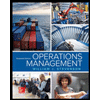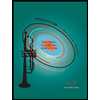The three-station work cell illustrated in the figure below has a product that must go through one of the two machines at station 1 (they are parallel) before proceeding to station 2. a) The bottleneck time of the system is minutes per unit (enter your response as a whole number). b) is the bottleneck station. c) The throughput time is minutes (enter your response as a whole number). d) If the firm operates 9 hours per day, 5 days per week, the weekly capacity of this work cell is units (enter your response as a whole number).
The three-station work cell illustrated in the figure below has a product that must go through one of the two machines at station 1 (they are parallel) before proceeding to station 2. a) The bottleneck time of the system is minutes per unit (enter your response as a whole number). b) is the bottleneck station. c) The throughput time is minutes (enter your response as a whole number). d) If the firm operates 9 hours per day, 5 days per week, the weekly capacity of this work cell is units (enter your response as a whole number).
Practical Management Science
6th Edition
ISBN:9781337406659
Author:WINSTON, Wayne L.
Publisher:WINSTON, Wayne L.
Chapter2: Introduction To Spreadsheet Modeling
Section: Chapter Questions
Problem 20P: Julie James is opening a lemonade stand. She believes the fixed cost per week of running the stand...
Related questions
Question
The three-station work cell illustrated in the figure below has a product that must go through one of the two machines at station 1 (they are parallel) before proceeding to station 2.
a) The bottleneck time of the system is
minutes per unit (enter your response as a whole number).
minutes per unit (enter your response as a whole number).
b) is the bottleneck station.
c) The throughput time is
minutes (enter your response as a whole number).
minutes (enter your response as a whole number).
d) If the firm operates
9 hours per day, 5 days per week, the weekly capacity of this work cell is
units (enter your response as a whole number).

Transcribed Image Text:This diagram illustrates a production workflow involving three stations, each with specific capacities.
**Station 1:**
- Consists of two machines:
- Machine A with a capacity of 30 units per hour.
- Machine B also with a capacity of 30 units per hour.
- Both machines feed into Station 2.
**Station 2:**
- Has a capacity of 6 units per hour.
- Receives input from both Machine A and Machine B of Station 1.
- Outputs to Station 3.
**Station 3:**
- Has a capacity of 2 units per hour.
- Receives input solely from Station 2.
**Workflow Explanation:**
The workflow begins at Station 1, where either Machine A or Machine B processes up to 30 units per hour. The processed items are then sent to Station 2, which can handle only 6 units per hour despite the higher input capacity. Finally, the output from Station 2 is sent to Station 3, which further reduces the processing capacity to 2 units per hour. This illustrates how bottlenecks can occur in a production line when downstream stations have lower capacities than upstream stations.
Expert Solution
This question has been solved!
Explore an expertly crafted, step-by-step solution for a thorough understanding of key concepts.
This is a popular solution!
Trending now
This is a popular solution!
Step by step
Solved in 2 steps

Recommended textbooks for you

Practical Management Science
Operations Management
ISBN:
9781337406659
Author:
WINSTON, Wayne L.
Publisher:
Cengage,

Operations Management
Operations Management
ISBN:
9781259667473
Author:
William J Stevenson
Publisher:
McGraw-Hill Education

Operations and Supply Chain Management (Mcgraw-hi…
Operations Management
ISBN:
9781259666100
Author:
F. Robert Jacobs, Richard B Chase
Publisher:
McGraw-Hill Education

Practical Management Science
Operations Management
ISBN:
9781337406659
Author:
WINSTON, Wayne L.
Publisher:
Cengage,

Operations Management
Operations Management
ISBN:
9781259667473
Author:
William J Stevenson
Publisher:
McGraw-Hill Education

Operations and Supply Chain Management (Mcgraw-hi…
Operations Management
ISBN:
9781259666100
Author:
F. Robert Jacobs, Richard B Chase
Publisher:
McGraw-Hill Education


Purchasing and Supply Chain Management
Operations Management
ISBN:
9781285869681
Author:
Robert M. Monczka, Robert B. Handfield, Larry C. Giunipero, James L. Patterson
Publisher:
Cengage Learning

Production and Operations Analysis, Seventh Editi…
Operations Management
ISBN:
9781478623069
Author:
Steven Nahmias, Tava Lennon Olsen
Publisher:
Waveland Press, Inc.